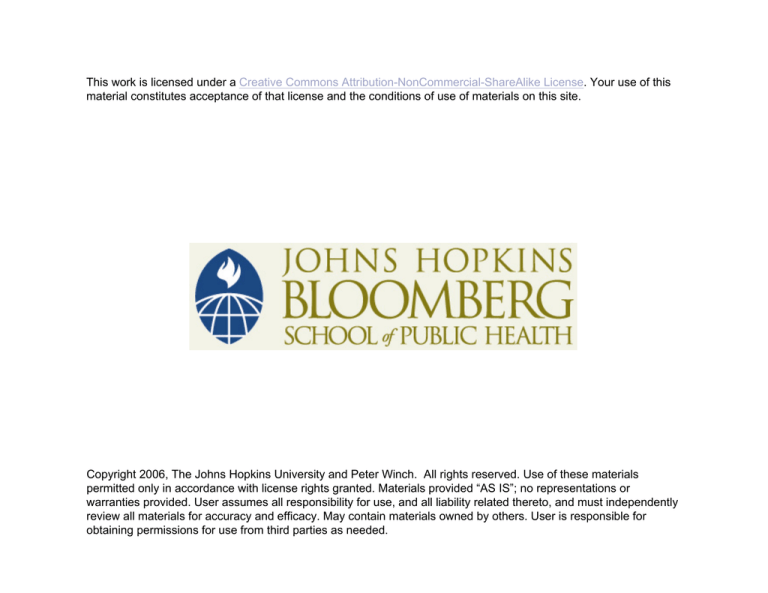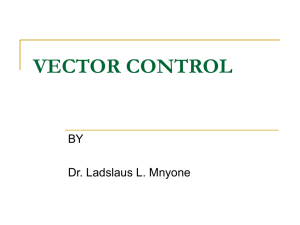
This work is licensed under a Creative Commons Attribution-NonCommercial-ShareAlike License. Your use of this
material constitutes acceptance of that license and the conditions of use of materials on this site.
Copyright 2006, The Johns Hopkins University and Peter Winch. All rights reserved. Use of these materials
permitted only in accordance with license rights granted. Materials provided “AS IS”; no representations or
warranties provided. User assumes all responsibility for use, and all liability related thereto, and must independently
review all materials for accuracy and efficacy. May contain materials owned by others. User is responsible for
obtaining permissions for use from third parties as needed.
Behavior Change Interventions
for Malaria Programs
Peter Winch
RBM Program Implementation
RBM is using a new approach to program
implementation
– Decentralized decision-making
– Collaboration between a variety of
partners in implementation
– Emphasis on behavior change at
household and community levels
Key RBM Interventions
Early and appropriate treatment of malaria,
especially in under-fives
Prevention and control of malaria in
pregnancy
Insecticide-treated mosquito nets
Key RBM Interventions
Each are supported by the results of highquality research that has demonstrated
their impact
Nevertheless, limited evidence of
significant decreases in malaria-related
mortality and morbidity in sub-Saharan
Africa, with some exceptions (Eritrea,
South Africa, Botswana, southern
Mozambique, parts of Tanzania)
Key RBM Interventions
Why aren’t we seeing greater results from
implementation of RBM interventions?
Early and appropriate treatment of
malaria, especially in under-fives
Early and Appropriate Treatment of
Malaria, Especially in Under-Fives
Approaches to implementation
– Health facilities
– Community health workers
– Mothers
– Private providers
Early and Appropriate Treatment of Malaria
by CHWs: Traditional Approach
Presumptive treatment of fever with firstline antimalarial
Referral of cases with signs of severity to
health facility
NO:
– Use of microscopy or diagnostic tests
– Training on assessment or management
of ARI/pneumonia
Example: CHW Program
in Southern Mali
Photo: Peter Winch
Health Indicators for Mali
from DHS Surveys
1995/6 DHS 2001 DHS
Total Fertility
Rate 15-49 yrs
Under five
mortality rate
6.7
6.8
237.6/
1000 live births
229.1/
1000 live births
Photo: Peter Winch
Structure of a Health Zone
Health
center
Village
drug kits
Photo: Peter Winch
Early and Appropriate Treatment of Malaria
by CHWs: Current Challenges
Chloroquine has been the gas in the tank
of CHW programs: Safe, effective, and
inexpensive. Alternatives are less safe and
more expensive.
Many Ministries of Health feel that
Artemisinin Combination Therapy (ACT)
should not be placed in the hands of CHWs
Issues Related to ACTs
High cost
– If paid by customer: Will customer be
willing to pay versus getting chloroquine
from the market
– If paid by government: Will government
allow CHW prescribing of ACTs, concern
about wastage
Counseling: Can CHWs effectively counsel
parents/patients on ACT administration?
RDTs: Many governments don’t want ACTs
given without positive microscope or RDT
RDTs
Some CHW programs have used
microscopy
Some examples of CHWs using RDTs,
minimal training and supervision needed
compared to microscopy:
– Mayxay M et al. An assessment of the
use of malaria rapid tests by village
health volunteers in rural Laos. Tropical
Medicine and International Health 2004;
9(3): 325-9.
– Used ParacheckPf and OptiMAL
Issues with RDTs
Cost compared to drugs, in Laos study:
– Paracheck Pf $0.75
– OptiMAL $1.95
What to do with people with negative RDT
who still want treatment?
What to do if people have signs of malaria
and are very sick, but negative RDT?
Discussion Question #1
In southern Mali would you:
– Allow CHWs to dispense ACTs?
– Train CHWs to use RDTs?
What do you do with people who test
negative with RDTs?
What behavior change communication
would be needed to introduce ACTs?
Sources of Care for Sick Children
Survey conducted in Bougouni District, Mali, April 2004, n=228
Appropriate sources of modern medications/care 99 (43.4%)
Community health centre
68 (29.8%)
District referral hospital
2 (0.9%)
Community health worker operating a drug kit
27 (11.8%)
Maternity/nurse’s aide
19 (8.3%)
Unauthorized sources of modern medications
124 (54.4%)
Vendors in the market
92 (40.4%)
Small shop/ambulatory vendor
43 (18.9%)
Pharmacy
5 (2.2%)
Traditional sources of care
170 (74.6%)
Traditional healer
53 (23.3%)
Old “wise” woman
59 (29.9%)
Traditional medications prepared by family
94 (41.2%)
Photo: Peter Winch
Photo: Peter Winch
Sources of Care for Sick Children
Survey conducted in Bougouni District, Mali, April 2004, n=228
Appropriate sources of modern medications/care
Community health centre
District referral hospital
Community health worker operating a drug kit
Maternity/nurse’s aide
What we
mostly
teach
about
Unauthorized sources of modern medications
Vendors in the market
Small shop/ambulatory vendor
Pharmacy
Traditional sources of care
Traditional healer
Old “wise” woman
Traditional medications prepared by family
What we
teach
very little
about
Intervention Models to Improve
Quality of Care in Private Sector
Increasing quality of care in pharmacies Î
Accredited Drug Dispensing Outlets
– www.msh.org/seam/country_programs/
3.1.4b.htm
Vendor-to-vendor interventions
– www.malariajournal.com/content/2/1/10
Negotiation (“contracts”) with private
providers to change behavior
– Trop Med Int Health. 2002 Mar;7(3):210-9
– Health Policy Plan. 2000 Dec;15(4):400-7.
Discussion Question #2
Should the private/informal sector be
involved in the introduction of ACTs?
How should the private/informal sector be
involved?
Improving Care During
the Rainy Season
The Major Constraints Converge
During the Rainy Season
How?
Why is it important?
Seasonality of Household
Expenditures and Revenues
During rainy seasons when malaria transmission
is greatest:
– Decrease in household revenue
– Increase in household expenditure
– Increase in workload
Resulting in:
– Less careseeking from health facilities
– Greater use of traditional medicine
Seasonal Variations in Patterns of
Illness Treatment, Burkina Faso
Dry season
No. households
566
No. individuals
4820
No. ill individuals
867 (18%)
Episodes/person
1.21
No. illness episodes 1050
No. episodes treated 674 (64.2%)
No. treatment
829
episodes
Rainy season
547
4634
636 (13.7%)
1.18
752
259 (34.4%)
282
Discussion Question #3
How would you improve access to
treatment during the rainy season in
Burkina Faso?
Discussion Question #4:
Constraints on Behavior in
Pregnant Adolescents
Burden of Malaria in Pregnancy
Malaria contributes to negative health impact of
both mothers and infants:
Mothers
¾3-15% of severe anemia
¾up to 10,000 malaria anemia-related deaths per
year
Infants
¾8-14% of all low birth weight
¾30% of preventable low birth weight
¾3-8% of infant mortality
Malaria in Pregnancy
Pregnancy makes women more vulnerable to
malaria, resulting in high morbidity and mortality:
– Malaria infection can lead to acute disease
and anemia
– Malaria parasites accumulate in the placenta
Anemia and placental malaria are associated with
low birth weight
Low birth weight is the single greatest risk factor
for neonatal death
Prevention Measures
Antimalarial drugs
– Chemoprophylaxis
– Presumptive intermittent therapy (PIT)
Insecticide- treated materials (ITMs)
Malaria in Pregnant Adolescents
BIOLOGICAL RISKS:
– Anemia common in adolescence
– Risk of malaria in pregnancy during first
gestation
– Reduced pelvic size: Pelvis still growing
– Risk of toxemia in first gestation
Malaria in Pregnant Adolescents
SOCIAL RISKS:
– First pregnancy may not be declared
until near the end
– No autonomy in decision making
– May have no previous contacts with
health system
– Less access to money
Discussion Question #4:
Malaria in Pregnant Adolescents
in Country X
Program is in place, but coverage is limited to
referral-care facilities and urban hospitals
Official policy has been chemoprophylaxis 2
tabs CQ/week from 8th wk, but this policy
never implemented
New policy is treatment with SP twice during
pregnancy at beginning of 2nd and 3rd
trimesters
Social and Cultural Factors
Don’t want to make their pregnancy public
May be abandoned by the family
– Mother and father reject her
– She goes to live with grandparents
Drop out of school
Questions for Example #4
You are director of RBM program in this
country. Coverage of program has been
restricted to the capital until recently.
– What are your proposed interventions
for preventing and treating malaria in
pregnancy?
– What is your strategy for reaching
adolescent girls?




